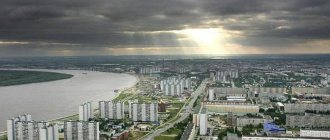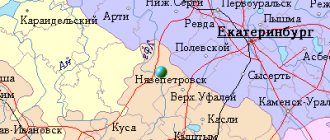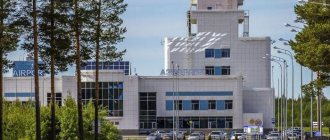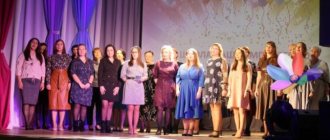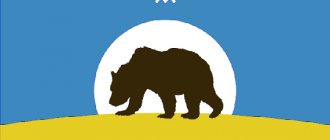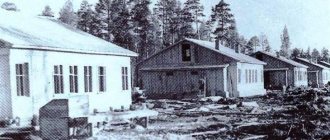Material from Documentation.
Jump to: navigation, search
Population of the Khanty-Mansiysk Autonomous Okrug
as of January 1, 2013 it was 1.58 million people. The share of the region's population in the Russian population is 1.1%.[1]
The population density of the Khanty-Mansiysk Autonomous Okrug was 2.96 people per km2 (35.3% of the same figure in Russia).[2]
In Ugra, the population mainly lives in urban areas - 1406.1 thousand people or 91.5% of the total population, in rural areas - 130.7 thousand people or 8.5%. The population density of the district is 2.9 people per 1 sq. km.[3]
The most populous cities are Surgut (308.5 thousand people or 20% of the total population of the district), Nizhnevartovsk (252.6 thousand people or 16.4% of the total population of the district), Nefteyugansk (123, 7 thousand people or 8% of the total population of the district). The administrative center of Khanty-Mansiysk ranks 5th among the cities of the district in terms of population - 79.8 thousand people, which is 5.2% of the total population of the district.[4]
Khanty-Mansi Autonomous Okrug - Ugra is the historical homeland of the indigenous population, which is represented by three small nationalities: Khanty, Mansi, Nenets. Indigenous peoples today make up about 2% of the total population of the district (30 thousand people). National composition of the population: 66.1% - Russians, 8.6% - Ukrainians, 7.5% - Tatars, 1.2% - Khanty, 0.7% - Mansi, 0.1 - Nenets, 15.8% - other nationalities.[5]
Ugra ranks 3rd among the constituent entities of the Russian Federation in terms of natural population growth. The migration increase in the district's population in 2010 amounted to 3.7 thousand people.[6]
The share of the population of working age is 69.6%, younger than working age - 19.9%, older than working age - 10.5%.[7]
Current statistics
At the beginning of 2021, Rosstat provides the following current data for the Khanty-Mansiysk Okrug - Ugra:
- At the beginning of the calendar period, the number of residents was 1,674,676 people.
- The region is the leader in the birth rate of the Russian part of the population. The birth rate over the past few years has been 16.2, compared to the all-Russian rate of 12.6.
- Here, despite the rather harsh climate, one of the lowest mortality rates. This figure in Khanty-Mansi Autonomous Okrug is 6.8, while the average for Russia reaches 14.3.
Happy birthday, Yugra!
Legendary and young, unbridled and progressive, generous and unique - our northern land is so different.
On December 10, the Autonomous Okrug turns 91 years old. For some, Yugra is their homeland from birth, the land of many generations of ancestors, as for Vitaly Kazamkin from Varyogan (pictured). Others - hardworking, talented, daring - came to conquer the oil fields and remained, themselves conquered by the riches of the region. Today, a new, younger generation continues the work they began, developing and preserving the spiritual heritage of the ancestors of the Ugra land. A unique region
Briefly about the main thing
The Khanty-Mansi Autonomous Okrug is located in the central part of the West Siberian Plain. The two great Siberian rivers Ob, Irtysh and their tributaries, 30 thousand large and small rivers, 300 thousand lakes form the water basin of the autonomy. The region's territory is 534 thousand square meters. km, it could accommodate seven countries like Belgium, or one like France. The population is more than 1.6 million people.
The Khanty, Mansi and Forest Nenets are the indigenous peoples of the North, for whom Ugra is their original place of residence. They have preserved the way of life of their ancestors and are still engaged in reindeer husbandry, fishing, and fur farming. The district takes great care in preserving and studying the Khanty and Mansi languages, in which books and newspapers are published, and television and radio programs are broadcast.. Yugra is the main oil and gas region of Russia, which provides 5% of world and 42% of all-Russian oil production. More than 12 billion tons of “black gold” have been extracted from its depths. Every 19 tons of oil produced in the world is from Yugra. Currently, the oil potential of the Autonomous Okrug is estimated at 35-40 billion tons. It ranks 1st among Russian regions in terms of oil production and 2nd place in terms of gas production.
.All types of transport are represented in the Autonomous Okrug, except the metro. The most popular is road transport. The total length of roads is more than 28.8 thousand km. There are 475 passenger cars per 1,000 inhabitants. There are 567 road and railway bridges in Ugra. The longest bridge in Siberia, 2,110 m long, is across the Ob River between Nefteyugansk and Surgut.
Our autonomy is the largest region in terms of population, completely classified as northern regions, and one of the “youngest”.
The average age of residents is 35.2 years. The sustainability of demographic development is achieved due to two factors: the young age structure of the population and the low mortality rate. The average life expectancy of Yugra residents is 75.4 years, which is 2.4% higher than the Russian average. The birth rate is 1.7 times higher than in European countries (France, Austria). We know how you can best receive news. Our official accounts on social networks: VKontakte, Facebook, Odnoklassniki, Twitter, Instagram, Yandex.Zen.
Area and information
Khanty-Mansi Autonomous Okrug is one of the constituent entities of the Russian Federation, which is territorially included in the Tyumen region. In terms of economic indicators, it is a donor region due to its developed oil and gas industry. The area of the Autonomous Okrug is 534,801 km².
In the Autonomous Okrug, by 2021, there are 16 cities, the number of which varies from 18,076 (Pokachi) to an urban agglomeration with a maximum number of residents of 380,000 in the city of Surgut.
Also, 24 urban-type settlements remain inhabited in the territory. However, it is worth noting that in the period from the 50s to the 80s there were more of them. At least 6 units. But the overwhelming number of them, over time and the development of industry, grew and transformed into cities, such as Nefteyugansk, Beloyarsk, Surgut and some others.
They were at first small settlements, but thanks to the fact that the industry associated with the extraction of minerals was productively established, they grew into fairly large cities with well-developed infrastructure.
[edit] Indigenous peoples
The indigenous small peoples of the Khanty-Mansi Autonomous Okrug, the Khanty and Mansi, are two related peoples. The ethnonyms “Khanty” and “Mansi” are derived from the self-name of the Khante, Kantakh and Mansi peoples. They were adopted as official names after 1917, and in the old scientific literature and in documents of the tsarist administration the Khanty were called Ostyaks, and the Mansi were called Voguls or Vogulichs.[8]
G.S. Dunin-Gorkavich, a researcher from the beginning of the century who visited these parts, describes the Khanty as follows: “The Ostyaks as a whole are distinguished by their good nature, willingness to help everyone and strict honesty. They do not harbor any enmity towards each other and live peacefully. Begging is unknown to the Ostyaks: every poor person considers himself to have the right to come to a wealthier person and enjoy food from him, especially after a good catch of an animal or fish. Among them there is even a kind of public charity, due to which every elderly and unable to work Ostyak, if he has no relatives, is fed in turn by his relatives.[9]
Murders among the Ostyaks, due to their peace-loving nature, can be said with confidence, do not occur at all. The Ostyaks were accustomed to respecting other people's property; therefore, theft and deception among them are extremely rare.”[10]
I. G. Ostroumov (1904) gives the Voguls the following characteristics: “By their nature, the Voguls are a peace-loving, kind-hearted and good-natured people; Their mutual relations are extremely good: they do not know what, for example, deception, theft, and especially murder are.”[11]
To designate the Khanty and Mansi as a single whole, another term has been established in the scientific literature - Ob Ugrians. Its first part indicates the main place of residence, and the second comes from the word “Ugra”, “Yugoria”. This is what it was called in Russian chronicles of the 11th-15th centuries. territory in the polar Urals and Western Siberia, as well as its inhabitants.[12]
Linguists classify the Khanty and Mansi languages as Ugric (Ugric); this group also includes the related language Hungarian. The Ugric languages are part of the Finno-Ugric group of the Uralic language family.[13]
Based on the fact that the Khanty and Mansi languages belong to the Finno-Ugric group, it is assumed that there once existed a community of people who spoke this proto-language. The question of where the ancestral home of this community was located is extremely complex. Despite the ambiguity and inconsistency of the origins of the Khanty and Mansi, researchers are unanimous in their opinion that their culture is two-component, incorporating the traditions of the local taiga tribes and the Ugrians who came from the south. Linguists suggest the possibility of ancient connections of the Uralic language family with the Indo-European and Turkic, there are parallels with the Yukaghir, Chukchi-Kamchatka, Eskimo-Aleut languages, connections with the Proto-Iranian languages have been discovered.[14]
There is a point of view according to which the ancestors of the Samoyeds and Ugrians developed the territory of Western Siberia from the Mesolithic (6 thousand BC), and in the Neolithic era (4 thousand BC) the proto-Samoyeds and proto-Ugrians emerged. This chronology is relative, since in modern science there are disputes regarding the identification of archaeological cultures with specific ethnic groups. Some scientists suggest the existence of cultural and historical communities within which the ancestors of different ethnic groups could live, the final separation of which occurred already in historical times.[15]
According to archaeological data, extensive trade relations between the population of Western Siberia can be traced back to 1 thousand years ago. e. Judging by the finds in ancient treasures and burials, at the turn of the era there was an exchange of goods with China, which, most likely, was carried out by merchants traveling through the territory of Western Siberia. Similar contacts took place later: in the 7th-8th centuries. - with Central Asia and northeastern Iran, in the 10th - with Volga Bulgaria through the Urals.[16]
In the later period of formation of the ethnic groups inhabiting Western Siberia, we can talk about interethnic contact. Ethnic contacts mean the presence of consanguineous and marital ties. This process is confirmed by ethnographic data on material and spiritual culture, in particular, materials on funeral rites, one of the most striking indicators of ethnicity.[17]
Interethnic ties existed among the Ob Ugrians with neighboring peoples: Nenets, Selkups, Komi-Zyryans, Siberian Tatars.[18]
If we talk about the nature of contacts between the indigenous peoples of Western Siberia and the Russian state, then initially they occurred at the level of commodity exchange (13-14 centuries). In the 15-16th centuries. Among the Khanty, Mansi, and Selkups, tribal unions appeared - principalities. The Siberian Tatars have an early feudal state formation - the Siberian Khanate. And after the capture of Kazan in 1552, when the borders between the Russian state and Siberia appeared, relations of a different nature were established. The process of annexing Siberia to the Muscovite kingdom begins. By this time, the Ugric and Samoyed population paid tribute to the Siberian Tatars and participated in military campaigns. But after Ermak’s campaigns in the 80s. 16th century, which is the starting point for the annexation of Western Siberia to the territory of Russia, indigenous peoples begin to pay tribute to the Russian state.[19]
All these cultural, historical and ethnic processes undoubtedly influenced the formation and design of the distinctive traditional culture of the Khanty and Mansi.[20]
The Khanty and Mansi were traditionally semi-sedentary hunters and fishermen; in addition, they were engaged in reindeer herding in the north and cattle breeding in the south. Hunters and fishermen had a seasonal settlement and home for each season. There were a lot of types of dwellings, some of them were temporary, collapsible, others were permanent. There were a variety of outbuildings, and there were places of worship.[21]
Household items were made from local materials: wood, birch bark, cedar root, etc. The clothes of the Khanty and Mansi differed significantly among the groups: among the northern ones, closed ones predominated (without a cut, worn over the head), among the southern and eastern ones - swinging ones. The ornamentation is rich and varied.[22]
In connection with the industrial development of the territory of the Khanty-Mansiysk Autonomous Okrug, the share of the migrant population has steadily increased; indigenous peoples today make up about 2% of the total population of the district.[23]
Cities
The administrative center is the city of Khanty-Mansiysk. The Autonomous Okrug also includes a number of the following large cities:
- Beloyarsky - the population here exceeds a little more than 19 thousand people.
- Kogalym - about 67 thousand people live in the agglomeration.
- Langelas - just over 44,000 inhabitants.
- Nefteyugansk is a large city by the standards of the region with more than 127,000 inhabitants.
- Nizhnevartovsk - more than 277,000 citizens live on its territory.
- Surgut is the largest populated area, with a population of more than 380 thousand people.
- Yugorsk with a population of 37,000, as well as a number of smaller settlements and smaller settlements.
Dynamics by year
Since the pre-war period, or more precisely since 1939, here is how the population in the region has changed:
- In 1939, the number of people living in the region was only 92,932.
- By 1959 it had increased to 123,926.
- By 1979 it was 569.139.
- In 1989 – 1.268.439.
- By 1999, the population continued to increase to 1,359,069 people.
- In 2009 it was equal to 1,519,962.
- For 2021, this figure was 1,663,795 citizens.
- And gradual growth continues through 2021 inclusive, thereby increasing the number of residents in this territory to more than 1.6 million.
It is worth noting that during the entire Soviet period of the Khanty-Mansi Autonomous Okrug and the Russian period, the population in the region increased almost continuously. The only exception is the period from 1992 to 1993. During this period, there was a decrease in the number of residents in the region by approximately 13,000 people. But then, starting in 1993, growth began to continue. This was achieved thanks to a developed economy and oil and gas deposits.
It is the oil and gas industry that gives economic impetus to the region and the opportunity to implement various economic and social programs. In addition, the high level of salaries, in comparison with other regions, made it possible to attract workers from certain industries here.
Ethnic composition
Considering the ethnic composition of the Khanty-Mansi Autonomous Okrug - Yugra, it is worth noting the following composition of the population in the Soviet and post-Soviet periods:
- Russian approximate figures predominate here - from 72% under the USSR to 68% in modern Russia.
- On the contrary, the Tatars increased their numbers in the Khanty-Mansiysk Okrug from 2% to more than 7%.
- Next in number are the Ukrainians - since the post-war period they have increased the number from 2% to more than 7%.
- But the Khanty, the indigenous population of the Khanty-Mansiysk Okrug, make up only a little more than 1% in 2020. Although during the Soviet period more than 9% lived here.
- Also living here are Bashkirs, Belarusians, Chuvashs, Kumyks, Mansi, Uzbeks, Tajiks, Chechens, Germans, Armenians, Nogais, Kyrgyz and other nationalities, but in proportionately smaller numbers.
[edit] Notes
- Main socio-economic indicators in 2012[1]
- Main socio-economic indicators in 2012[2]
- General information about the district[3]
- General information about the district[4]
- General information about the district[5]
- General information about the district[6]
- General information about the district[7]
- Indigenous peoples
- Indigenous peoples
- Indigenous peoples
- Indigenous peoples
- Indigenous peoples
- Indigenous peoples
- Indigenous peoples
- Indigenous peoples
- Indigenous peoples
- Indigenous peoples
- Indigenous peoples
- Indigenous peoples
- Indigenous peoples
- Indigenous peoples
- Indigenous peoples
- Indigenous peoples
| Population of Russia | |
| Story | Old Russian state • Russian kingdom • Russian empire • USSR • 1990s (1991, 1992, 1993, 1994, 1995, 1996, 1997, 1998, 1999) • 2000s (2000, 2001, 2002, 2003, 2004, 2005, 2006, 2007, 2008, 2009) • 2010s (2010, 2011, 2012, 2013, 2014, 2015, 2021, 2021, 2021, 2019) • 2020s (2020, 2021, 202 2, 2023, 2024, 2025, 2026, 2027, 2028, 2029) |
| Floor | Men • Women |
| Central Federal District | Belgorod region • Bryansk region • Vladimir region • Voronezh region • Ivanovo region • Kaluga region • Kostroma region • Kursk region • Lipetsk region • Moscow region • Oryol region • Ryazan region • Smolensk region • Tambov region • Tver region • Tula region • Yaroslavl region • Moscow |
| Northwestern Federal District | Karelia • Komi • Arkhangelsk region • Nenets Autonomous Okrug • Vologda region • Kaliningrad region • Leningrad region • Murmansk region • Novgorod region • Pskov region • St. Petersburg |
| Southern Federal District | Adygea • Kalmykia • Crimea • Krasnodar region • Astrakhan region • Volgograd region • Rostov region • Sevastopol |
| North Caucasian Federal District | Dagestan • Ingushetia • Kabardino-Balkaria • Karachay-Cherkessia • North Ossetia • Chechnya • Stavropol Territory |
| Volga Federal District | Bashkortostan • Mari El • Mordovia • Tatarstan • Udmurtia • Chuvashia • Perm region • Kirov region • Nizhny Novgorod region • Orenburg region • Penza region • Samara region • Saratov region • Ulyanovsk region |
| Ural Federal District | Kurgan region • Sverdlovsk region • Tyumen region • Khanty-Mansi Autonomous Okrug • Yamalo-Nenets Autonomous Okrug • Chelyabinsk region |
| Siberian Federal District | Altai • Buryatia • Tyva • Khakassia • Altai region • Transbaikal region • Krasnoyarsk region • Irkutsk region • Kemerovo region • Novosibirsk region • Omsk region • Tomsk region |
| Far Eastern Federal District | Yakutia • Kamchatka Territory • Primorsky Territory • Khabarovsk Territory • Amur Region • Magadan Region • Sakhalin Region • Jewish Autonomous Region • Chukotka Autonomous Okrug |
Source - ""
Category: Population of the Khanty-Mansiysk Autonomous Okrug
Gender and age
Considering the distribution by gender in the region, it is worth noting that the number of women here, since 2005, has always prevailed over the number of men. Here are the indicators Rosstat shows, indicating the number of women per 1,000 men:
- In 2005, the fairer sex numbered 1,026.
- In 2010 – 1041.
- By 2014 – already 1052.
- By 2021 – 1053 women.
- And by 2021, there were 1,054 women per 1,000 men.
As can be seen, under the influence of a number of factors, including the shorter life expectancy of men, the number of women per 1000 males is constantly growing. If we consider age indicators, then today the age composition of the population is divided as follows by the end of 2021:
- Children under 1 year – 22,500.
- Children under 7 years old – 186,000.
- From 8 to 13 years – 136,000.
- From 14 to 17 years old – 80100.
- From 18 to 19 – 31.000.
- From 20 to 24 – 83.600.
- From 25 to 29 – 110.200.
- From 30 to 34 – 161.500.
- From 35 to 39 – 154.600.
- From 40 to 44 – 136,300 people.
- From 45 to 49 – 119.500.
- From 50 to 54 years old – 109,500.
- From 55 to 59 years old – 127,200.
- In the age group 60-64 years – 95,500.
- In the range from 65 to 69 years – 58,000.
- Over 70 – a little over 52,000.
Thus, the working population is a total of 1003,700 citizens, the younger than working population is 386,600. But the pension category of people is 273,500.
Migration
If we consider migration issues, here is what the inflow and outflow of the population looks like year by year over the past few years:
- 76217 people arrived in 2021.
- In 2021, this figure was 75,582.
- The bulk of arrivals are Russians who migrate within the country. Their number accordingly amounted to about 66,000 over 2 years.
- Of international migration, most citizens came from Azerbaijan, Armenia, and Tajikistan. Less so from other Slavic republics of the former USSR.
- But the picture will be incomplete if we do not say that there is a category of people who leave Khanty-Mansi Autonomous Okrug. So, for the same reporting period from 17 to 18. XXI century, the number of those leaving was about 80,000 annually. Moreover, the main part moves within the country, settling in other regions.
This is what the demographic situation looks like in the Khanty-Mansiysk Autonomous Okrug. And now it has a positive character compared to many other regions of the country.
History of the Khanty-Mansiysk Autonomous Okrug-Ugra
The population of the district, according to Rosstat data as of January 1, 2014, was 1597.0 thousand people. The national composition of the district's population is dominated by Russians, Ukrainians, Tatars, and Bashkirs.
The indigenous (aboriginal) population is represented by three small nationalities - the Khanty, Mansi and Forest Nenets. Their total number is about 1.5%.
Governor of Khanty-Mansi Autonomous Okrug - Natalya Komarova (since 2010).
Two large rivers flow through the territory of the district: the Ob, with a length of 3,650 kilometers, and its tributary, the Irtysh, with a length of 3,580 kilometers. The climate of the district is temperate continental. It is characterized by sudden changes in weather in spring and autumn, and temperature changes during the day.
The district occupies most of the territory of the West Siberian oil and gas province and is one of the largest oil-producing regions in the world. About 7% of the world's oil and about half of Russian oil, and more than 4% of the volume of all-Russian gas are produced here.
As of 2013, on the territory of the Autonomous Okrug, 467 hydrocarbon fields were included in the balance sheet, including 406 oil fields, 22 gas and gas condensate fields, 39 oil and gas condensate fields, oil and gas fields and gas and oil fields. The largest are Samotlorskoye, Fedorovskoye, Mamontovskoye, Priobskoye.
The largest volume of extracted oil was obtained in the Surgut, Nizhnevartovsk, Nefteyugansk and Khanty-Mansiysk regions.
In 2014, the region produced 250.5 million tons of oil and 31,771.5 million cubic meters of natural and associated gas.
Most of the oil reserves of the distributed subsoil fund (95%) are listed on the balance sheet of the largest vertically integrated oil companies, OJSC Rosneft, OJSC LUKOIL, OJSC Surgutneftegaz, OJSC Slavneft, OJSC Gazprom Neft and OJSC Russneft. .
Placer gold is mined in the district (forecast gold reserves exceed 216 tons), vein quartz and collection raw materials. Deposits of brown and hard coal have been discovered. Deposits of iron ore, copper, zinc, lead, niobium, tantalum, manifestations of bauxite, etc. were discovered.
The region has created the most powerful electric power complex in the country. The main share of electricity generation in the territory of the Autonomous Okrug is provided by OJSC Surgutskaya GRES-1, OJSC Surgutskaya GRES-2, OJSC Nizhnevartovskaya GRES and Nyaganskaya GRES.
The Khanty-Mansiysk Autonomous Okrug - Ugra is an export-oriented region, in the total volume of foreign trade turnover the share of exports is 95.6%, the share of imports is 4.4%. Mineral fuels, oil and their distillation products, bituminous substances, mineral waxes are exported; wood, charcoal. Of the total export volume, 99.4% is crude oil.
The development of innovations occupies a special place in the economy of Ugra. To support subjects of innovative activity in the region, the following were created: the autonomous institution of the Khanty-Mansiysk Autonomous Okrug - Ugra “Technopark of High Technologies”, non-profit organizations “Ugra Entrepreneurship Support Fund”; "Development Fund of the Khanty-Mansiysk Autonomous Okrug - Ugra", "Microfinance Fund of the Khanty-Mansiysk Autonomous Okrug - Ugra". There are 130 innovative companies in the region, most of which are residents of the Technopark.
All research activities in Ugra are concentrated in higher educational institutions of the district.
The system of higher professional education in Khanty-Mansi Autonomous Okrug consists of two regional universities and an academy, as well as two federal universities - Yugra State University and Nizhnevartovsk State University.
18 small innovative enterprises have been created at universities. They are engaged in research activities in which students also participate.
On the territory of the Autonomous Okrug there are historical and cultural monuments: museums, theaters, archaeological complexes. There are 35 museums and their branches in Ugra. Most museums are historical, local history and ethnographic.
Khanty-Mansiysk is home to the Torum Maa ethnographic open-air museum, founded in 1987. The museum broadcasts the living culture of the indigenous peoples of the North. In addition to exhibiting rare objects, the Torum Maa Museum holds ritual holidays of the indigenous peoples of the North.
There are two state reserves in the district - Yugansky and Malaya Sosva, four natural parks, and eight nature reserves.
Every year the district center becomes a platform for international cinema. Guests and participants of the festival of cinematic debuts “Spirit of Fire” are coming to Ugra. It was established by the government of the Khanty-Mansiysk Autonomous Okrug and the Ministry of Culture of the Russian Federation in 2002.
The material was prepared based on information from open sources
